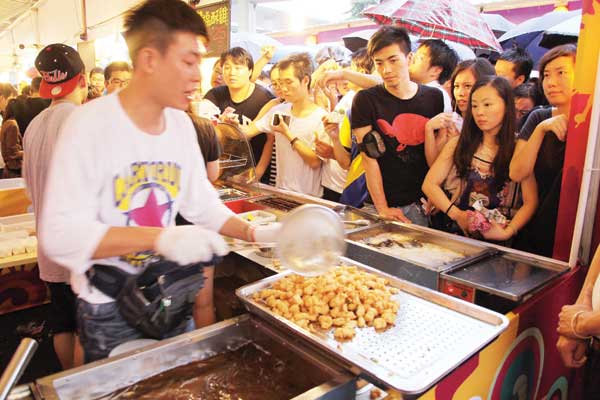

Supper is a very important meal for the Chinese. The tradition of after-dark snacking dates back to the Tang Dynasty (AD 618-907), when a late-night curfew was lifted on important dates.
These days, however, it's the lifestyle change of staying up late to work or play that creates the need for an extra meal to replenish and recharge.
Shanghai residents are known for being China's epicures, and recently they gave their endorsement of the traditional snacks of Taipei's Shilin night market brought to the city for a food festival.
It certainly proves that the love of good food knows neither geographical barriers nor political divisions, and that both cities share a common appreciation of the good things in life.
In this issue, we help satiate those late-night longings with a list of where to go and what to eat in Shanghai. Wang Zhenghua files the reports.
They traveled far from right across town, perhaps 20 kilometers or more, and waited in line for up to two hours for a 20-yuan ($3) snack that was demolished in three minutes.
The downpour on opening day did not dampen Shanghai's eagerness to get a taste of true-blue street food from Taipei, and not even unhappy comments left online by a few frustrated by the weather and the wait could deter them.
Shanghai's Jinjiang Action Park has worked with Taipei's Shi-Lin Tourism Development Association to bring 30 stalls from the famous Shilin night market to the amusement park.
Despite publicity that only depended on online social media, more than 15,000 eager diners swarmed to the park to get a taste of an authentic oyster omelet, sausage wrapped in glutinous rice and other famous night-market snacks so often featured on talk shows or soap operas from across the Straits.
So what was so attractive to these eager gourmands? Was it truly genuine Taiwan flavor?
Ray Lin, from Kaohsiung on the island, says the food he tried — salty crisp chicken and soft fried prawns — tasted the same as the ones he had back home.
The fried and battered prawns — about the size of a banana —were wrapped in cheese before they were coated with breadcrumbs and deep-fried, much like an oversized tempura.
Every bite was tender, and the special sweet chili sauce helped cleanse the palate.
"Actually this is a snack you can find only at major night markets such as Shilin," he says. "It's not too common."
Other recommended items include the well-known oyster omelet, sausage wrapped in glutinous rice, papaya milk, boiled brined chicken and barbecue on a slate in the aboriginal style.
Prices ranged from 15 to 30 yuan per portion.
For Ya Wei, a native of Harbin, the food is so tasty that she and her boyfriend were feasting without a break.
Other diners had higher standards, and one lady from Shanghai insisted that the beef noodles could not compare with what she ate in Taipei.
"The texture of both the beef and noodle is not good enough. The beef tendons were not tender," she complains.
Savoring a Central ‘outdoor oasis‘
2014-05-12Savoring food and fuss at mom‘s table
2014-04-29Savoring South China yum cha in five-star style
2014-04-21Copyright ©1999-2018
Chinanews.com. All rights reserved.
Reproduction in whole or in part without permission is prohibited.